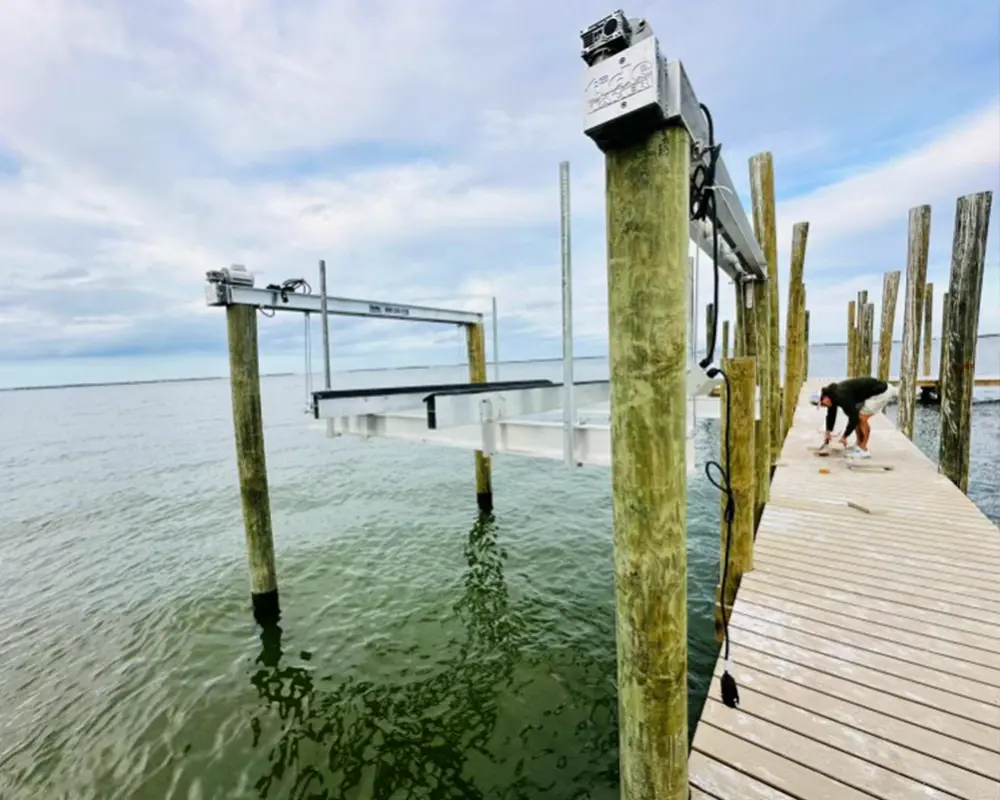“In 2022 alone, Florida faced over $116 billion in storm damage, making it the costliest hurricane season in U.S. history.”
If you live on the water in Florida, you already know: hurricane season isn’t a matter of if — it’s a matter of when. And while your home and belongings might be the first things that come to mind when storms are brewing, your dock and waterfront structures are just as vulnerable. One bad storm can rip pilings from the seabed, twist aluminum lifts into scrap, and send debris flying down the canal.
Let’s talk strategy. Because when it comes to protecting your dock, waiting until a storm is three days out is already too late.
1. Inspect and Reinforce Ahead of Time
Before the clouds roll in, do a full dock check. Don’t just glance. Walk the entire length, feel for loose boards, look under the framing, and tug on cleats and hardware.
What to look for:
- Loose decking or rotted planks
- Wobbly railings or posts
- Rusted or corroded bolts
- Cracks in pilings or signs of shifting
What to do:
- Replace rotted wood with marine-grade lumber or composite like WearDeck™
- Tighten or replace corroded hardware with stainless steel
- Reinforce joints with hurricane clips or brackets
Solid maintenance now can mean the difference between minor damage and total loss. For more tips on preparing your marine structures, read our dedicated blog post here.
2. Secure or Remove Everything That Moves
Your dock isn’t just wood and nails. It’s also boat lifts, jet ski ports, furniture, ladders, bumpers, fish cleaning tables, lighting — the list goes on.
If it can be removed, take it off.
- Chairs? Store them.
- Ladders? Unscrew and stash.
- Dock boxes? Empty them, strap them down, or relocate them.
For boat lifts:
- Raise lifts as high as they go and disconnect power.
- If possible, remove the cradle beams.
- Don’t leave a boat on the lift during a hurricane. It acts like a sail.
Loose items become airborne missiles. And even small ones can turn into expensive liabilities.
3. Consider Installing Breakaway Panels
Breakaway panels are designed to detach under extreme pressure, reducing stress on the entire structure.
They save your dock by sacrificing themselves.
Installed along the outer edges of a dock, these panels come loose in surge or wave action, preventing uplift forces from taking the whole deck with them.
Ask your contractor about integrating them if your dock doesn’t already have this feature.
4. Upgrade Your Materials
Not all docks are created equal. If yours is still made with untreated wood or basic galvanized fasteners, it may not survive a strong storm.
Smart upgrades include:
- Composite decking (like WearDeck): Resists moisture, UV, and warping
- Stainless steel or hot-dipped galvanized fasteners: Avoids rust and long-term decay
- Helical or deep-set pilings: More resistance against surge and shifting soils
Think of it as storm-proofing, not just beautifying.
5. Document Everything
If you ever need to file an insurance claim, having detailed documentation can be the difference between full coverage and frustrating denials.
Steps to take:
- Photograph your dock and all equipment before hurricane season
- Note any serial numbers or manufacturer information for lifts and accessories
- Keep receipts or invoices for upgrades
Bonus tip: share copies with your insurance agent now. Don’t wait.
6. Post-Storm Inspection: Don’t Assume It’s Safe
After the storm, it’s tempting to step onto your dock right away. Don’t.
Inspect first from land or a safe distance. Look for:
- Loose or missing boards
- Exposed nails or hardware
- Leaning pilings or cracked supports
Use caution with electrical systems. Saltwater intrusion can cause unseen damage that could shock or injure.
Call a professional if anything looks off. Better to be safe.
And if you have questions about repairing or replacing your dock, you can read more here.
7. Work With Local Pros Who Understand Florida Storms
Florida marine environments are unique. Tides, current, salt, and hurricanes, it takes a contractor who knows the terrain.
At Overall Outdoor & Marine Services, we build with storm resilience in mind. That means:
- Smart design for wind and water flow
- Heavy-duty materials that stand the test of time
- Emergency response crews ready after the storm
Whether it’s reinforcing what you have or replacing what didn’t make it, we’re here for the long haul.
Final Thoughts
You can’t hurricane-proof your entire life, but you can prepare. Your dock is an investment in your waterfront lifestyle, don’t leave it up to luck.
Take the steps now to strengthen, secure, and storm-proof your structure. And if you want help? Call the pros who do this every season.
Let’s make sure the only thing floating away is last year’s stress.
FAQ: Dock Hurricane Protection
A: No. Boats act like giant sails and can rip lifts apart. If possible, trailer it inland or use a hurricane-rated dry stack facility.
A: As high as it goes. Disconnect power and, if possible, remove the cradle beams.
A: Only if absolutely necessary, and only with proper storm mooring techniques. Floating docks or pilings designed for surge are required.
A: Sometimes. Many policies exclude or limit dock coverage. Check with your provider before the storm.
A: Composite like WearDeck offers superior durability, moisture resistance, and lower maintenance.
Need help getting your dock hurricane-ready? Reach out to Overall Outdoor & Marine Services. We’ll walk you through every step — from prep to rebuild.

